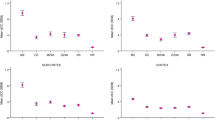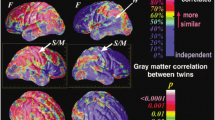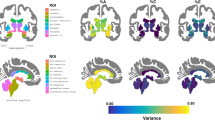Abstract
The Human Connectome Project (HCP) provides a rich dataset of quantitative and domain-specific behavioral measures from twins and extensive family structures. This makes the dataset a unique and a valuable resource to investigate heritability and determine individual differences. Using a set of measures of behavioral domains (motor, emotion, personality, sensory, and cognition), we estimated the intraclass correlations (ICCs) and heritability of 56 behavioral measures for 4 genetically identified groups of participants: monozygotic (MZ) twins, dizygotic (DZ) twins, non-twin siblings (SB), and unrelated individuals (NR). The ICCs range varied among behavioral domains but systematically so among the four genetic groups. We found the same rank order of ICCs, from the highest values for MZ twins, statistically significantly smaller for the DZ twins and sibling group (compared to MZ), and close to zero for NR. The mean heritability values of the five behavioral domains were: cognition h2 = 0.405, emotion h2 = 0.316, motor h2 = 0.138, personality h2 = 0.444, and sensory h2 = 0.193. These domains share overlapping brain networks. The heritability of motor domain was significantly smaller than cognitive, personality, and emotion domains. These findings provide new insight into the effect of genetics on the various diverse behavioral measures.







Similar content being viewed by others
References
Asbury K, Moran N, Plomin R (2016) Nonshared environmental influences on academic achievement at age 16: a qualitative hypothesis-generating monozygotic-twin differences study. AERA 2(4):2332858416673596
Barch DM, Burgess GC, Harms MP, Petersen SE, Schlaggar BL, Corbetta M et al (2013) Function in the human connectome: task-fMRI and individual differences in behavior. Neuroimage 15(80):169–189
Bevilacqua L, Goldman D (2011) Genetics of emotion. Trends Cogn Sci 15:401–408. https://doi.org/10.1016/j.tics.2011.07.009
Briley DA, Tucker-Drob EM (2013) Explaining the increasing heritability of cognitive ability across development: a meta-analysis of longitudinal twin and adoption studies. Psychol Sci 24(9):1704–1713. https://doi.org/10.1177/0956797613478618
Bouchard TJ, Loehlin JC (2001) Genes, evolution, and personality. Behav Genet 31(3):243–273
Bouchard TJ, McGue M (1990) Genetic and rearing environmental influences on adult personality: an analysis of adopted twins reared apart. J Pers 58(1):263–292. https://doi.org/10.1111/j.1467-6494.1990.tb00916.x
Burri A, Ogata S, Rice D, Williams FMK (2018) Twelve-year follow-up of chronic pain in twins: changes in environmental and genetic influence over time. Eur J Pain 22(8):1439–1447
Burri A, Ogata S, Vehof J, Williams F (2015) Chronic widespread pain: clinical comorbidities and psychological correlates. Pain 156(8):1458–1464
Chamoun E, Mutch DM, Allen-Vercoe E, Buchholz AC, Duncan AM, Spriet LL et al (2018) A review of the associations between single nucleotide polymorphisms in taste receptors, eating behaviors, and health. Crit Rev Food Sci Nutr 58(2):194–207
de Ridder DTD, Lensvelt-Mulders G, Finkenauer C, Stok FM, Baumeister RF (2012) Taking stock of self-control: a meta-analysis of how trait self-control relates to a wide range of behaviors. Pers Soc Psychol Rev 16(1):76–99
Dolan RJ (2002) Emotion, cognition, and behavior. Science 298(5596):1191–1194. https://doi.org/10.1126/science.1076358
Falconer DS (1965) The inheritance of liability to certain diseases, estimated from the incidence among relatives. Ann Hum Genet 29(1):51–76. https://doi.org/10.1111/j.1469-1809.1965.tb00500.x
Falconer DS, Mackay TCF (1996) Introduction to quantitative genetics, 4th edn. Longman Group, London
Feinstein L, Bynner J (2004) The importance of cognitive development in middle childhood for adulthood socioeconomic status, mental health, and problem behavior. Child Dev 75(5):1329–1339
Fisher RA (1958) Statistical methods for research workers. Hafner, New York
Giraudeau B (1996) Negative values of the intercalss correlation coefficient are not theoretically possible. J Clin Epidemiol 49:1205–1206
Han Y, Adolphs R (2020) Estimating the heritability of psychological measures in the Human Connectome Project dataset. PLoS ONE 15(7):e0235860. https://doi.org/10.1371/journal.pone.0235860
Hanushek EA, Woessmann L (2012) Do better schools lead to more growth? Cognitive skills, economic outcomes, and causation. J Econ Growth 17(4):267–321
Haworth CMA, Wright MJ, Luciano M, Martin NG, de Geus EJC, van Beijsterveldt CEM, Plomin R (2010) The heritability of general cognitive ability increases linearly from childhood to young adulthood. Mol Psychiatry 15(11):1112–1120. https://doi.org/10.1038/mp.2009.55
Jang KL, Livesley WJ, Vemon PA (1996) Heritability of the big five personality dimensions and their facets: a twin study. J Pers 64(3):577–592. https://doi.org/10.1111/j.1467-6494.1996.tb00522.x
Jansen AG, Mous SE, White T, Posthuma D, Polderman TJC (2015) What twin studies tell us about the heritability of brain development, morphology, and function: a review. Neuropsychol Rev 25(1):27–46. https://doi.org/10.1007/s11065-015-9278-9
Johnson W (2011) Beyond heritability: twin studies in behavioral research. Curr Dir Physol Sci 18(4):217–220. https://doi.org/10.1111/j.1467-8721.2009.01639.x.Beyond
Kato K, Sullivan PF, Evengård B, Pedersen NL (2006) Importance of genetic influences on chronic widespread pain. Arthritis Rheum 54(5):1682–1686
King MJ, Katz DP, Thompson LA, Macnamara BN (2019) Genetic and environmental influences on spatial reasoning: a meta-analysis of twin studies. Intelligence 73:65–77
Knowles EEM, Carless MA, de Almeida MAA, Curran JE, McKay DR, Sprooten E et al (2014) Genome-wide significant localization for working and spatial memory: identifying genes for psychosis using models of cognition. Am J Med Genet B Neuropsychiatr Genet 165(1):84–95
Langfelder P, Zhang B, Horvath S (2008) Defining clusters from a hierarchical cluster tree: the dynamic tree cut package for R. Bioinformatics 24(5):719–720
Larsen SA, Byrne B, Little CW, Coventry WL, Ho CS, Olson RK et al (2019) Identical genes, unique environments: a qualitative exploration of persistent monozygotic-twin discordance in literacy and numeracy. Front Educ 4:21
Lau JYF, Burt M, Leibenluft E, Pine DS, Rijsdijk F, Shiffrin N et al (2009) Individual differences in children’s facial expression recognition ability: the role of nature and nurture. Dev Neuropsychol 34(1):37–51
Little CW, Haughbrook R, Hart SA (2017) Cross-study differences in the etiology of reading comprehension: a meta-analytical review of twin studies. Behav Genet 47(1):52–76
Luna B, Garver KE, Urban TA, Lazar NA, Sweeney JA (2004) Maturation of cognitive processes from late childhood to adulthood. Child Dev 75(5):1357–1372
Marcus DS, Harms MP, Snyder AZ, Jenkinson M, Wilson JA, Glasser MF et al (2013) Human Connectome Project informatics: quality control, database services, and visualization. Neuroimage 80:202–219. https://doi.org/10.1016/j.neuroimage.2013.05.077
Mann FD, DeYoung CG, Tiberius V, Krueger RF (2019) Social-relational exposures and well-being: using multivariate twin data to rule-out heritable and shared environmental confounds. J Res Pers 83:103880
Mansfield KE, Sim J, Jordan JL, Jordan KP (2016) A systematic review and meta-analysis of the prevalence of chronic widespread pain in the general population. Pain 157(1):55–64
Martin NG, Eaves LJ (1977) The genetical analysis of covariance structure. Heredity 38(1):79–95
Mayhew AJ, Meyre D (2017) Assessing the heritability of complex traits in humans: methodological challenges and opportunities. Curr Genomics 18(4):332–340
McCrae RR, Costa PT Jr (1997) Personality trait structure as a human universal. Am Psychol 52(5):509–516. https://doi.org/10.1037/0003-066X.52.5.509
McCrae RR, Costa PT (2004) A contemplated revision of the NEO five-factor inventory. Personal Individ Differ 36(3):587–596
Michelon P (2006) What are cognitive skills and abilities? SharpBrains. Retrieved Oct 7, 2019. https://sharpbrains.com/blog/2006/12/18/what-are-cognitive-abilities/
Missitzi J, Gentner R, Misitzi A, Geladas N, Politis P, Klissouras V, Classen J (2013) Heritability of motor control and motor learning. Physiol Rep 1(7):e00188. https://doi.org/10.1002/phy2.188
National Center for Education Statistics (2013) The nation’s report card: a first look: 2013 mathematics and reading (NCES 2014–451). Institute of Education Sciences, US Department of Education, Washington, DC
Plomin R (1990) The role of inheritance in behavior. Science 248:183–188
Plomin R, Deary LJ (2015) Genetics and intelligence differences: five special findings. Mol Psychiatry 20:98–108
Polderman TJC, Benyamin B, de Leeuw CA, Sullivan PF, van Bochoven A, Visscher PM, Posthuma D (2015) Meta-analysis of the heritability of human traits based on fifty years of twin studies. Nat Genet 47(7):702–709. https://doi.org/10.1038/ng.3285
Power RA, Pluess M (2015) Heritability estimates of the Big Five personality traits based on common genetic variants. Transl Psychiatry 5(7):e604. https://doi.org/10.1038/tp.2015.96
Rappaport LM, Carney DM, Verhulst B, Neale MC, Blair J, Brotman MA et al (2018) A developmental twin study of emotion recognition and its negative affective clinical correlates. J Am Acad Child Adolesc Psychiatry 57(12):925–933.e3
Reed T, Fabsitz RR, Selby JV, Carmelli D (1991) Genetic influences and grip strength norms in the NHLBI twin study males aged 59–69. Ann Hum Biol 18(5):425–432
Sanchez-Roige S, Gray JC, MacKillop J, Chen C-H, Palmer AA (2018) The genetics of human personality. Genes Brain Behav 17(3):e12439
Toga AW, Thompson PM (2005) Genetics of brain structure and intelligence. Annu Rev Neurosci 28:1–23
Trost Z, Strachan E, Sullivan M, Vervoort T, Avery AR, Afari N (2015) Heritability of pain catastrophizing and associations with experimental pain outcomes: a twin study. Pain 156(3):514–520. https://doi.org/10.1097/01.j.pain.0000460326.02891.fc
Turkheimer E (2000) Three laws of behavior genetics and what they mean. Curr Dir Psychol Sci 9(5):160–164. https://doi.org/10.1111/1467-8721.00084
UNESCO (2009) World report. Investing in cultural diversity and intercultural dialogue. UNESCO, Paris
Van Essen DC, Smith SM, Barch DM, Behrens TEJ, Yacoub E, Ugurbil K (2013) The WU-Minn Human Connectome Project: an overview. Neuroimage 80:62–79. https://doi.org/10.1016/j.neuroimage.2013.05.041
Vazsonyi AT, Mikuška J, Kelley EL (2017) It’s time: a meta-analysis on the self-control-deviance link. J Crim Justice 48:48–63
Vukasović T, Bratko D (2015) Heritability of personality: a meta-analysis of behavior genetic studies. Psychol Bull 141(4):769–785
Willems YE, Boesen N, Li J, Finkenauer C, Bartels M (2019) The heritability of self-control: a meta-analysis. Neurosci Biobehav Rev 100:324–334
Winkler AM, Harms MP, Burgess GC, Glahn DC, Smith SM et al (2015) Investigation into the heritabilities of some traits in the Human Connectome Project. Poster Session presented at: 21st Human Brain Mapping, Honolulu, HI, USA
Zempo H, Miyamoto-Mikami E, Kikuchi N, Fuku N, Miyachi M, Murakami H (2017) Heritability estimates of muscle strength-related phenotypes: a systematic review and meta-analysis. Scand J Med Sci Sports 27(12):1537–1546
Zempo H, Miyamoto-Mikami E, Fuku N, Murakami H (2019) Heritability estimates of physical performance-related phenotypes. Chapter two In: Barh D, Ahmetov II (eds) Sports, exercise, and nutritional genomics. Academic Press, pp 23–39
Zhang C, Dougherty CC, Baum SA, White T, Michael AM (2018) Functional connectivity predicts gender: evidence for gender differences in resting brain connectivity. Hum Brain Mapp 39(4):1765–1776
Acknowledgements
Data were provided by the Human Connectome Project, WU-Minn Consortium (Principal Investigators: David Van Essen and Kamil Ugurbil; 1U54MH091657) funded by the 16 NIH Institutes and Centers that support the NIH Blueprint for Neuroscience Research; and by the McDonnell Center for Systems Neuroscience at Washington University.
Author information
Authors and Affiliations
Corresponding author
Additional information
Communicated by Francesco Lacquaniti.
Publisher's Note
Springer Nature remains neutral with regard to jurisdictional claims in published maps and institutional affiliations.
Rights and permissions
About this article
Cite this article
Christova, P., Joseph, J. & Georgopoulos, A.P. Behavioral–genetic associations in the Human Connectome Project. Exp Brain Res 238, 2445–2456 (2020). https://doi.org/10.1007/s00221-020-05893-w
Received:
Accepted:
Published:
Issue Date:
DOI: https://doi.org/10.1007/s00221-020-05893-w




